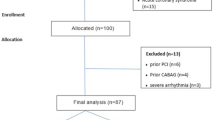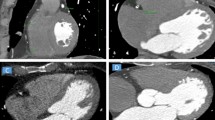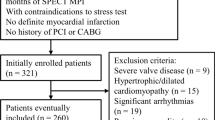Abstract
Background
Epicardial fat volume (EFV) has been reported to be associated with coronary artery disease (CAD). CAD is the leading cause of myocardial ischemia and myocardial ischemia is closely related to major adverse cardiovascular events. We hypothesized that EFV could provide incremental value to traditional risk factors and coronary artery calcium score (CACS) in predicting myocardial ischemia in Chinese patients with suspected CAD.
Methods
We retrospectively studied 204 Chinese patients with suspected CAD who underwent single-photon emission computerized tomography-myocardial perfusion imaging (SPECT-MPI) combined with computed tomography (CT). Pericardial contours were manually defined, and EFV was automatically calculated. A reversible perfusion defect with summed difference score (SDS) ≥ 2 was defined as myocardial ischemia.
Results
The myocardial ischemia group had higher EFV than normal MPI group (137.80 ± 34.95cm3 vs. 106.63 ± 29.10 cm3, P < .001). In multivariable logistic regression analysis, high EFV was significantly associated with myocardial ischemia [odds ratio (OR): 8.30, 95% CI: 3.72-18.49, P < .001]. Addition of EFV to CACS and traditional risk factors could predict myocardial ischemia more effectively, with larger AUC .82 (P < .001), positive net reclassification index .14 (P = .04) and integrated discrimination improvement .14 (P < .001). The bootstrap resampling method (times = 500) was used to internally validation and calculate the 95% confidence interval (CI) of the AUC (95% CI .75-.87). The calibration curve for the probability of myocardial ischemia demonstrated good agreement between prediction and observation.
Conclusions
In Chinese patients with suspected CAD, EFV was significantly associated with myocardial ischemia, and improved prediction of myocardial ischemia above traditional risk factors and CACS.




Similar content being viewed by others
Abbreviations
- EAT:
-
Epicardial adipose tissue
- EFV:
-
Epicardial fat volume
- CACS:
-
Coronary artery calcium score
- 99mTc-MIBI:
-
99MTechnetium-sestamibi
- SPECT:
-
Single-photon emission computerized tomography
- MPI:
-
Myocardial perfusion imaging
- CT:
-
Computed tomography
- CAD:
-
Coronary artery disease
- SSS:
-
Summed stress score
- SRS:
-
Summed rest score
- SDS:
-
Summed difference score
References
Baker AR, Harte AL, Howell N, Pritlove DC, Ranasinghe AM, da Silva NF, et al. Epicardial adipose tissue as a source of nuclear factor-kappaB and c-Jun N-terminal kinase mediated inflammation in patients with coronary artery disease. J Clin Endocrinol Metab 2009;94:261-7.
Mazurek T, Zhang L, Zalewski A, Mannion JD, Diehl JT, Arafat H, et al. Human epicardial adipose tissue is a source of inflammatory mediators. Circulation 2003;108:2460-6.
Moharram MA, Aitken-Buck HM, Reijers R, Hout IV, Williams MJ, Jones PP, et al. Correlation between epicardial adipose tissue and body mass index in New Zealand ethnic populations. N Z Med J 2020;133:22-32.
Sun DF, Kangaharan N, Costello B, Nicholls SJ, Emdin CA, Tse R, et al. Epicardial and subcutaneous adipose tissue in Indigenous and non-Indigenous individuals: Implications for cardiometabolic diseases. Obes Res Clin Pract 2020;14:99-102.
Nixdorf M, Schmidt JG, Grönemeyer D, Seibel R, Slomiany U, Beck EM, et al. Noncoronary measures enhance the predictive value of cardiac CT above traditional risk factors and cac score in the general population. JACC Cardiovasc Imaging 2016;9:1177-85
Otaki Y, Hell M, Slomka PJ, Schuhbaeck A, Gransar H, Huber B, et al. Relationship of epicardial fat volume from noncontrast CT with impaired myocardial flow reserve by positron emission tomography. J Cardiovasc Comput Tomogr 2015;9:303-9.
Khawaja T, Greer C, Thadani SR, Kato TS, Bhatia K, Shimbo D, et al. Increased regional epicardial fat volume associated with reversible myocardial ischemia in patients with suspected coronary artery disease. J Nucl Cardiol 2015;22:325-33.
Hell MM, Ding X, Rubeaux M, Slomka P, Gransar H, Terzopoulos D, et al. Epicardial adipose tissue volume but not density is an independent predictor for myocardial ischemia. J Cardiovasc Comput Tomogr 2016;10:141-9.
Zhou J, Chen Y, Zhang Y, Wang H, Tan Y, Liu Y, et al. Epicardial fat volume improves the prediction of obstructive coronary artery disease above traditional risk factors and coronary calcium score. Circ Cardiovasc Imaging 2019;12:e008002
Kunadian V, Chieffo A, Camici PG, Berry C, Escaned J, Maas A, et al. An EAPCI Expert Consensus Document on Ischaemia with Non-obstructive coronary arteries in collaboration with European Society of Cardiology Working Group on Coronary Pathophysiology & Microcirculation Endorsed by Coronary Vasomotor Disorders International Study Group. Eur Heart J 2020;41:3504-20.
Radico F, Zimarino M, Fulgenzi F, Ricci F, Di Nicola M, Jespersen L, et al. Determinants of long-term clinical outcomes in patients with angina but without obstructive coronary artery disease: A systematic review and meta-analysis. Eur Heart J 2018;39:2135-46.
Ronan G, Wolk MJ, Bailey SR, Doherty JU, Douglas PS, Hendel RC, et al. ACCF/AHA/ASE/ASNC/HFSA/HRS/SCAI/SCCT/SCMR/STS 2013 multimodality appropriate use criteria for the detection and risk assessment of stable ischemic heart disease: a report of the American College of Cardiology Foundation Appropriate Use Criteria Task Force, American Heart Association, American Society of Echocardiography, American Society of Nuclear Cardiology, Heart Failure Society of America, Heart Rhythm Society, Society for Cardiovascular Angiography and Interventions, Society of Cardiovascular Computed Tomography, Society for Cardiovascular Magnetic Resonance, and Society of Thoracic Surgeons. J Nucl Cardiol 2014;21:192-220.
Zhou J, Liu Y, Huang L, Tan Y, Li X, Zhang H, et al. Validation and comparison of four models to calculate pretest probability of obstructive coronary artery disease in a Chinese population: A coronary computed tomographic angiography study. J Cardiovasc Comput Tomogr 12017;1:317-23.
He ZX, Hedrick TD, Pratt CM, Verani MS, Aquino V, Roberts R, et al. Severity of coronary artery calcification by electron beam computed tomography predicts silent myocardial ischemia. Circulation 2000;101:244-51.
McClelland RL, Chung H, Detrano R, Post W, Kronmal RA. Distribution of coronary artery calcium by race, gender, and age: results from the Multi-Ethnic Study of Atherosclerosis (MESA). Circulation 2006;113:30-7.
Shao XL, Wang YT, Wang JF, Zhou RJ, Ke HY, Yang YS. Characteristics of coronary artery calcium and its relationship to myocardial ischemia in Chinese patients with suspected coronary artery disease. Hell J Nucl Med 2016;19:105-10.
Berman DS, Abidov A, Kang X, Hayes SW, Friedman JD, Sciammarella MG, et al. Prognostic validation of a 17-segment score derived from a 20-segment score for myocardial perfusion SPECT interpretation. J Nucl Cardiol 2004;11:414-23.
Xu Y, Fish M, Gerlach J, Lemley M, Berman DS, Germano G et al. Combined quantitative analysis of attenuation corrected and non-corrected myocardial perfusion SPECT: Method development and clinical validation. J Nucl Cardiol 2010;17:591-9.
Allman KC, Shaw LJ, Hachamovitch R, Udelson JE. Myocardial viability testing and impact of revascularization on prognosis in patients with coronary artery disease and left ventricular dysfunction: A meta-analysis. J Am Coll Cardiol 2002;39:1151-8.
Mahaisavariya P, Detrano R, Kang X, Garner D, Vo A, Georgiou D, et al. Quantitation of in vitro coronary artery calcium using ultrafast computed tomography. Cathet Cardiovasc Diagn 1994;32:387-93.
Huang G, Wang D, Zeb I, Budoff MJ, Harman SM, Miller V, et al. Intra-thoracic fat, cardiometabolic risk factors, and subclinical cardiovascular disease in healthy, recently menopausal women screened for the Kronos Early Estrogen Prevention Study (KEEPS). Atherosclerosis 2012;221:198-205.
Collins GS, Reitsma JB, Altman DG, Moons KG. Transparent reporting of a multivariable prediction model for individual prognosis or diagnosis (TRIPOD): The TRIPOD statement. BMJ 2015;350:g7594
Tamarappoo B, Dey D, Shmilovich H, Nakazato R, Gransar H, Cheng VY, et al. Increased pericardial fat volume measured from noncontrast CT predicts myocardial ischemia by SPECT. JACC Cardiovasc Imaging 2010;3:1104-12.
Janik M, Hartlage G, Alexopoulos N, Mirzoyev Z, Mclean DS, Arepalli CD, et al. Epicardial adipose tissue volume and coronary artery calcium to predict myocardial ischemia on positron emission tomography-computed tomography studies. J Nucl Cardiol 2010;17:841-7.
Haider A, Possner M, Messerli M, Bengs S, Osto E, Maredziak M, et al. Quantification of intrathoracic fat adds prognostic value in women undergoing myocardial perfusion imaging. Int J Cardiol 2010;292:258-64.
Tanami Y, Jinzaki M, Kishi S, Matheson M, Vavere AL, Rochitte CE, et al. Lack of association between epicardial fat volume and extent of coronary artery calcification, severity of coronary artery disease, or presence of myocardial perfusion abnormalities in a diverse, symptomatic patient population: Results from the CORE320 multicenter study. Circ Cardiovasc Imaging 2015;8:e002676
Chaldakov GN, Beltowsky J, Ghenev PI, Fiore M, Panayotov P, Rancic G, et al. Adipoparacrinology-vascular periadventitial adipose tissue (tunica adiposa) as an example. Cell Biol Int Rep 2012;36:327-30.
Sacks HS, Fain JN. Human epicardial adipose tissue: a review. Am Heart J 2007;153:907-17.
Yudkin JS, Eringa E, Stehouwer CD. “Vasocrine” signalling from perivascular fat: A mechanism linking insulin resistance to vascular disease. Lancet (London, England) 2005;365:1817-20.
Sade LE, Eroglu S, Bozbaş H, Ozbiçer S, Hayran M, Haberal A, et al. Relation between epicardial fat thickness and coronary flow reserve in women with chest pain and angiographically normal coronary arteries. Atherosclerosis 2009;204:580-5.
Shaw LJ, Iskandrian AE. Prognostic value of gated myocardial perfusion SPECT. J Nucl Cardiol 2004;11:171-85.
Ito T, Suzuki Y, Ehara M, Matsuo H, Teramoto T, Terashima M, et al. Impact of epicardial fat volume on coronary artery disease in symptomatic patients with a zero calcium score. Int J Cardiol 2013;167:2852-8.
Nakazato R, Dey D, Cheng VY, Gransar H, Slomka PJ, Hayes SW, et al. Epicardial fat volume and concurrent presence of both myocardial ischemia and obstructive coronary artery disease. Atherosclerosis 2012;221:422-6.
Romijn MA, Danad I, Bakkum MJ, Stuijfzand WJ, Tulevski II, Somsen GA, et al. Incremental diagnostic value of epicardial adipose tissue for the detection of functionally relevant coronary artery disease. Atherosclerosis 2015;242:161-6.
Murthy VL, Naya M, Taqueti VR, Foster CR, Gaber M, Hainer J, et al. Effects of sex on coronary microvascular dysfunction and cardiac outcomes. Circulation 2014;129:2518-27.
Jayawardena E, Li D, Nakanishi R, Dey D, Dailing C, Qureshi A, et al. Non-contrast cardiac CT-based quantitative evaluation of epicardial and intra-thoracic fat in healthy, recently menopausal women: Reproducibility data from the Kronos Early Estrogen Prevention Study. J Cardiovasc Comput Tomogr 2020;14:55-9.
Disclosure
The authors have indicated they have no financial conflicts of interest.
Author information
Authors and Affiliations
Corresponding author
Additional information
Publisher's Note
Springer Nature remains neutral with regard to jurisdictional claims in published maps and institutional affiliations.
The authors of this article have provided a PowerPoint file, available for download at SpringerLink, which summarizes the contents of the paper and is free for re-use at meetings and presentations. Search for the article DOI on SpringerLink.com.
The authors have also provided an audio summary of the article, which is available to download as ESM, or to listen to via the JNC/ASNC Podcast.
Funding
This research was supported by National Natural Science Foundation of China (81871381, PI: Yuetao Wang), key laboratory of Changzhou high-tech research project (CM20193010, PI: Yuetao Wang), Chinese National Natural Science Foundation for Young Scholars (81701737, PI: Jianfeng Wang), Social Development Foundation of Changzhou Science and Technology Bureau, Jiangsu Province, China (CE20175029, PI: Jianfeng Wang), Chinese National Natural Science Foundation for Young Scholars (81701734, PI: Xiaoliang Shao), Chinese National Natural Science Foundation for Young Scholars (81901777, PI: Feifei Zhang), science and technology project for youth talents of Changzhou Health Committee
Supplementary Information
Below is the link to the electronic supplementary material.
Rights and permissions
About this article
Cite this article
Yu, W., Zhang, F., Liu, B. et al. Incremental value of epicardial fat volume to coronary artery calcium score and traditional risk factors for predicting myocardial ischemia in patients with suspected coronary artery disease. J. Nucl. Cardiol. 29, 1583–1592 (2022). https://doi.org/10.1007/s12350-021-02538-5
Received:
Accepted:
Published:
Issue Date:
DOI: https://doi.org/10.1007/s12350-021-02538-5




